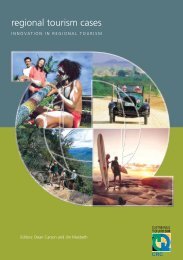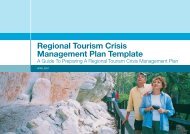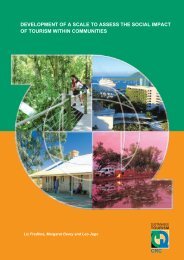Tourism Risk Management - Sustainable Tourism Online
Tourism Risk Management - Sustainable Tourism Online
Tourism Risk Management - Sustainable Tourism Online
You also want an ePaper? Increase the reach of your titles
YUMPU automatically turns print PDFs into web optimized ePapers that Google loves.
INTRODUCTION<br />
The purpose of this guide is to provide tourism industry members in Asia, the Pacific and beyond with<br />
an authoritative guide to risk management. Importantly, the generic risk management process has<br />
been adapted to the specific needs of tourism. The guide provides a practical framework within which<br />
tourism destinations can identify, analyse, evaluate, treat, monitor and review risks in the tourism<br />
context. Although the tourism risk management process has been developed for destinations, the<br />
same principles also apply to a tourism business or organization and can easily be adapted for their<br />
purposes.<br />
Throughout this guide there are two fundamental roles for tourism in risk management: the first of<br />
these is as a partner with government and community agencies in the development of multi-agency,<br />
coordinated disaster management plans, systems, procedures and processes which include the<br />
needs of tourism; the second is to develop plans and procedures appropriate to a destination and to<br />
the specific roles and responsibilities of an organization, to train personnel to those plans, and to<br />
conduct regular tests of plans, procedures and personnel with subsequent amendment and update.<br />
Although the tourism industry is not responsible for the development or implementation of community<br />
disaster management plans and arrangements, the guide recommends that destinations and tourism<br />
operators should, when possible, participate in disaster planning and management activities through<br />
appropriate local, regional or national committees. Such participation enables the importance of<br />
tourism to be drawn to the attention of disaster management agencies and promotes the need for<br />
appropriate measures to be established to protect visitors in times of crisis. Case studies of<br />
Hurricane Katrina and the Bali Bombings demonstrate how a community disaster can affect<br />
confidence in tourism and interfere with its ability to continue normal operations.<br />
While each tourist destination is unique and will have different issues to deal with, there are key<br />
areas of risk management which are common across destinations. The most obvious is a dramatic<br />
drop in visitor numbers in which the impact is felt across a whole economy. While this guide presents<br />
case studies of recent events which have had a significant impact on tourism, the focus is on<br />
solutions rather than merely documenting past difficulties. The guide also provides checklists which<br />
will assist destinations and tourism businesses to adopt current risk management processes.<br />
This guide draws on best practice from a range of sources within and outside the APEC group.<br />
Current knowledge and practical application are the objectives of the project, so that peak bodies<br />
(UNWTO, PATA, etc) can use material from this report for training and education programs.<br />
Recognizing the critical role of national governments in supporting and protecting tourist destinations,<br />
the guide also seeks to offer an authoritative guide that can be endorsed by governments.<br />
Chapter Summaries<br />
In order to demonstrate the importance of tourism, Chapter 1 begins with an overview of the need to<br />
protect tourism, focusing particularly on the economic significance of the tourism industry to all<br />
economies. Selected case studies reinforce the value of tourism by showing the economic losses<br />
associated with adverse events.<br />
Having established the importance of tourism for generating income, creating and sustaining jobs,<br />
encouraging foreign investment and facilitating trade opportunities, Chapter 2 then considers the key<br />
elements of crises and disasters and their effects upon tourism businesses/organizations and<br />
destinations and identifies the role of the tourism industry in risk management. The chapter provides<br />
a practical framework within which tourism destinations and businesses/organizations can identify,<br />
analyse, evaluate, treat, monitor and review risks and identifies the critical role of tourism operators in<br />
<strong>Tourism</strong> <strong>Risk</strong> <strong>Management</strong> – An Authoritative Guide to Managing Crises in <strong>Tourism</strong> 1
















